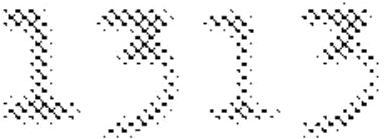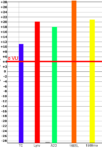For many when confronted with the terms dBFS, dBu, +4/-10, VU, etc their eyes gloss over. Without understanding a few simple concepts, integrating your DAW with external hardware can be a game of trial & frustration.
To properly drive & take full advantage of hardware in the analog realm, you need to 1st understand what signal level the device is designed to receive. This is when dBu comes into play.
- dBu – (dB in reference to 1 mW at 600 ohms, equal to 0.775 V) All you really need to know is this is a measurement standard for audio signals.
Most professional audio gear is made/calibrated to function in a +4 dBu = 0VU environment. This means when a +4 dBu signal hits the hardware input, it will read 0 VU on the hardware’s VU meter.
- VU – Unit of measurement originally developed in 1939 by the combined effort of Bell Labs and broadcasters CBS and NBC for measuring and standardizing the levels of telephone lines.
The question that often comes up is “How do my DAW levels relate to my hardware?”
First off we need to know what level your audio interface is designed to output. For example, lets take a look at my mobile rig using a TC StudioKonnect 48. From checking the tech specs, I see the SK48 has a max output of +13 dBu. This means when my DAW software reads 0 dBFS peak, the SK48 is outputting +13 dBu via the analog outputs.
- dBFS – Decibels relative to full-scale. (Digital full-scale) How most DAW/Digital processors meter.
To find out what level = 0 VU from of your DAW/audio interface you can:
- Patch into a piece of hardware you know to have properly calibrated VU meters. Send out a 1k tone until the VU meter reads 0 VU.
- (recommended method) Get yourself a digital multimeter (DMM). 0 vu = 1.23 AC Volts RMS (1.227 actually). Send out a 1k tone until the DMM reads 1.23 AC Volts RMS. (Measure the +/- leads. Pins 2 & 3 of a xlr or tip & ring of a TRS connector) Keep note of the dBFS level that you’re sending out of your DAW. This dBFS level = 0 vu for your rig/audio interface.
For my TC SK48 I measured -9 dBFS in the DAW to equal 0 VU in the outside analog world.
So what does this all mean? Well I now know that any signal lingering around -9 dBFS +/- 10 dB from my TC is perfectly fine to interact with typical +4 dBu hardware inputs.
Now lets think about headroom. We have established most hardware devices will understand how to handle/function in a +4 dBu environment. But still every hardware device will have its own maximum signal it can receive/output. This means every device will have a different amount of headroom over 0 VU.
My TC interface has a maximum output of +13 dBu, & my Lynx converters have a maximum of +20 dBu. The Lynx outputs 0 VU at -16 dBFS (via the DAW), this works out to make the Lynx have 7 dBu more headroom over 0 VU then the TC interface. Is this better? Potentially, but in most scenarios no. It is only useful if you’re trying to send a hotter signal to a device without input/output gain control.
Lets go over inputs. All hardware will have a dBu spec for its inputs as well. The device will usually have a matching dBu spec for both its inputs/outputs. For example my TC interface can handle a +13 dBu signal at its input without the pad engaged. If you created a loop, whatever you send out of the TC will be the same dBFS level coming back into the TC.
Now say you wanted to send a 0 VU signal from the TC & return via the Lynx converter. As previously calculated I need to send a -9 dBFS signal from my TC/DAW to = 0 VU. Because the Lynx is a +20 dBu device this will not return as -9 dBFS in the DAW. It will come back as -16 dBFS. You would have to add 7 dB of gain to match the original dBFS level.
Now for some real world examples –
Say I want to compress a signal from my TC/DAW, into a 1176, & back into my DAW via my API-A2D converters. The 1176 will operate fine with a signal from my TC, being that both are made to function in a +4 dBu = o VU environment. But I also know that my API-A2D converter has a +18 dBu maximum input rating. With The TC being a +13 device, I will have to gain the output up +5 dBu to equal the same dBFS level on the return into the DAW. It’s all simple math.
One final thing that should be noted is country-based reference standards. In the US, -20 dBFS = 0 VU / in Europe, – 18 dBFS = 0 VU. If you wanted to calibrate your DAW/studio to function at this calibration, you will have to have -/+ trim ability on your audio interface/converters. This works out to be +24 dBu for US & +22 dBu for EU. For example, if I wanted to calibrate my TC based studio to have -20 dBFS = 0 VU, I would have to externally trim my +13 dBu outputs +11 dB & attenuate my inputs -11 dB to function at this calibration. I would have to build a line level amplifier for my i/o. More realistically, I would just trim my DAW session down -11 dB if I wanted to process my session setting in a -20 calibrated studio. Unless you’re wanting to transfer sessions & outboard settings with other studios, this is unnecessary. You’re better off calibrating your studio based on your interface.
With this information you should be able to figure out how to drive your outboard/console from your DAW with proper gain staging.







Very good article that explains a very important aspect of well made recordings and mixes, unintentional distortion really is just about the worst problem with audio and this will explain how gain structure relates to the world of DAW’s. Good work.
This is great, and comprehensive, but a little vague in places, though I can tell you’ve tried to make it as scientific as possible, yet remain comprehensible to the layman. Is it possible you could elaborate on the points I’ve marked below with asteriks.
“So what does this all mean? Well I now know that any healthy signal peaking around -10 dBFS +/- 10 dB from my TC is *** perfectly fine to interact *** with my external +4 dBu hardware inputs.”
“We have established most devices will all *** equally understand how *** to handle/function in a +4 dBu environment.”
“So I know the 1176 will *** operate fine *** with a signal from my TC”
Maybe you could expand on what is “fine” and what isn’t “fine”. What are the consequences of mismatching levels and impedence? Is “not fine” a matter of distortion? Loss of highs? What?
I agree, I’ll take some time to revise/clarify when available.
Thanks man, can’t wait to read it, you’re a great source for this technical stuuf… and it can be a little difficult to understand sometimes.
You are mistaking the headroom of the t.c. / headroom of the Lynx to the operating level calibration of both units. This is wrong. Operating level is operating level – headroom is headroom. The two are mutually exclusive. As for whether or not having 20dbu of headroom is better than having 13dbu of headroom… yes, it is. Very much so. Without getting into a long dissertation about why its better I’ll give you the short [overly simplistic] version… which is that the amplifiers don’t have to work as hard which helps keep them closer to linear in their response and nature… which is a good thing.
Thanks for chiming in. When mix/matching devices you have understand how the operating level will relate to the maximum dBu of the devices throughout the chain. This is essentially what I’ve tried to explain. But yes it’s no doubt that devices with higher dBu handling have advantages, That’s another conversation.
In addition i’m in the camp of calibrating a studio to set operating level standards. This is a must in my world of interchanging between multiple studios around town. Some prefer to modify the device operating level based on the source. I’m personally not a fan.